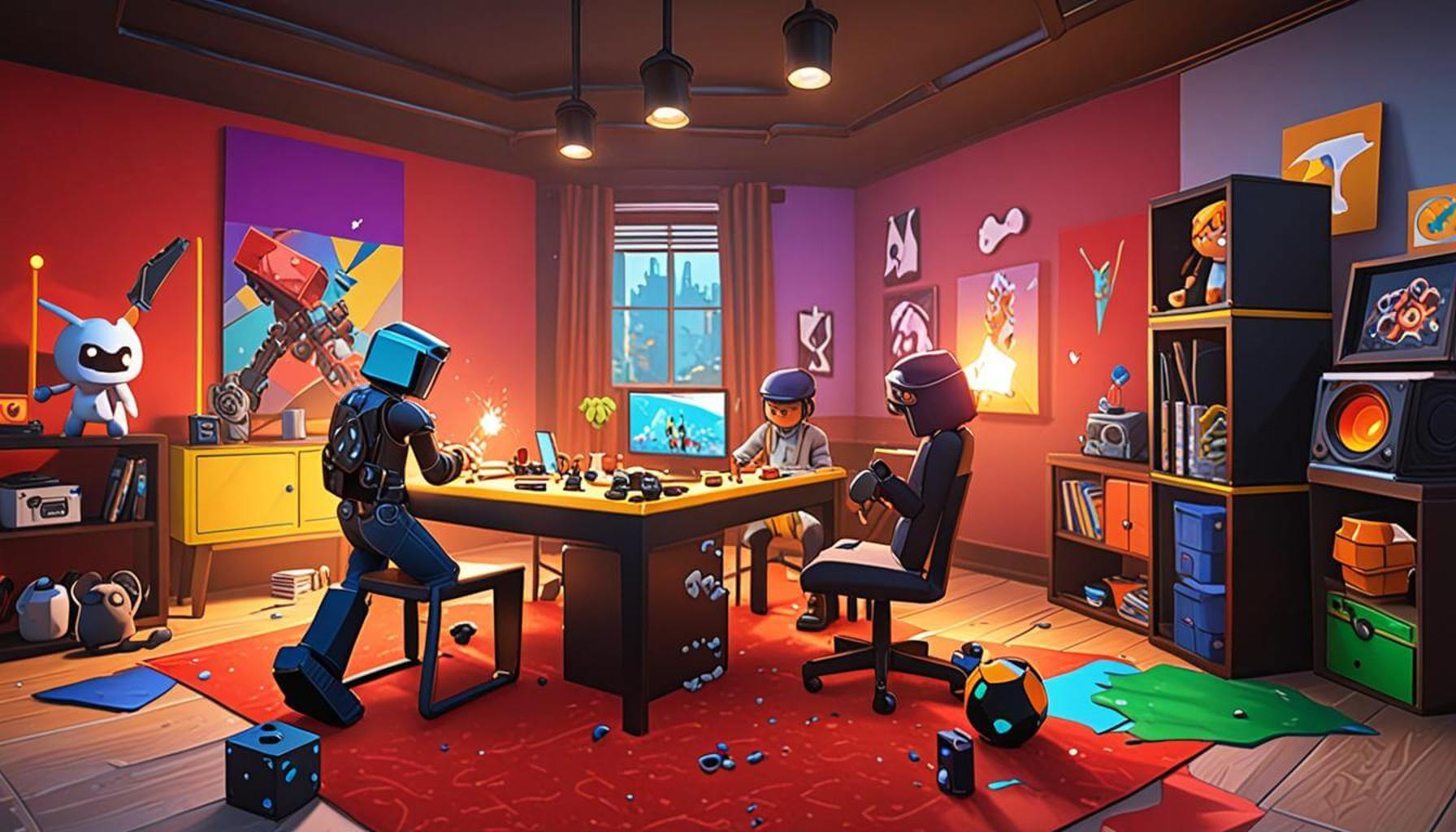The Role of Real-Time Interactions in Gaming Experiences in Roblox

Anúncios
The Evolution of Player Interaction in Gaming
In tandem with the evolution of technology, real-time interactions have become a cornerstone of modern gaming experiences, reshaping how players engage with fantastical realms and each other. A prime example of this transformation can be found in Roblox, an online platform that empowers millions to unleash their creativity by designing, sharing, and exploring diverse games crafted by fellow players. This unique mix of community-driven development and interactive gameplay elevates Roblox beyond traditional gaming, making it a noteworthy force in the entertainment landscape.
Anúncios
Real-time interactions facilitate a multitude of player experiences, offering significant advantages:
- Instant Communication: Players are equipped with chat features that allow them to communicate effortlessly, whether they’re brainstorming strategies, sharing tips, or simply socializing. For instance, in games like Adopt Me!, players can chat in real-time to negotiate trades or collaborate on building their dream virtual homes.
- Collaborative Gameplay: Many Roblox games, such as Brookhaven or Tower of Hell, emphasize teamwork, illustrating how real-time collaboration can enhance gameplay. Participants often rely on each other’s skills to overcome challenges, creating a dynamic and engaging environment where everyone’s contributions are valued.
- Dynamic Content: Game developers on Roblox can promptly adjust their creations based on real-time feedback from players. This adaptability allows for constant innovation; for instance, a game may receive updates that introduce new levels or characters within days of a player suggesting an idea, ensuring a fresh gaming experience.
The immersive nature of these interactions fosters connections that go beyond the screen, nurturing a sense of community among participants. Players often form friendships that span different gaming sessions, contributing to a vibrant social fabric that makes Roblox immensely popular among diverse age groups, particularly children and teens. In 2022, it was reported that over half of players aged 9 to 12 years in the United States spent considerable time on the platform, highlighting its influence on a younger demographic.
Anúncios
Such influential engagement through real-time interactions enables not only a participatory culture but also encourages players to remain actively involved, driving their loyalty to the platform. Understanding the dynamics of these interactions is critical for both game developers and players, as it shapes the future of gaming experiences. As this article explores, the impact of real-time interactions proves essential in establishing Roblox as a thriving hub for creativity and innovation.
DISCOVER MORE: Click here to dive deeper
The Impact of Real-Time Interactions on Gameplay Dynamics
In the vibrant universe of Roblox, real-time interactions serve as a catalyst for immersive gameplay, facilitating a unique environment where players can manipulate their surroundings while simultaneously engaging with one another. This level of interaction is not merely a supplementary feature; it is fundamental to the overall gaming experience, shaping how players approach challenges, collaborate, and thrive in virtual worlds.
One of the primary aspects of real-time interactions is the ability to communicate instantly, which significantly influences gameplay dynamics. This communication plays a critical role in various game genres within Roblox, from adventure quests to simulation games. For example, in highly competitive settings like Arsenal, the ability to share strategies or alert teammates about enemy positions alters the course of the game, offering a strategic advantage. Here are some ways real-time interactions enhance gameplay:
- Enhanced Strategy Development: Players can create and adapt strategies on the fly, responding to dynamic in-game situations. As players interact in real-time, they can pivot their approaches based on immediate feedback, increasing their chances of success.
- Shared Experiences: Collaborative games allow for shared victories and defeats. Titles like Jailbreak exemplify the thrill of teamwork, where players coordinate their efforts in real time to execute escapes or complete missions, fostering camaraderie and shared objectives.
- Real-Time Problem Solving: Players facing challenges can seek assistance or advice from others instantly. This cooperative problem-solving not only improves individual skills but also strengthens the collective experience, as players can learn from each other.
The psychological benefits of real-time interactions in Roblox cannot be understated. Studies indicate that social connections forged in gaming contexts can significantly boost players’ engagement and retention. For younger audiences, the chance to meaningfully communicate with peers can contribute to their social development, reinforcing skills such as teamwork, negotiation, and conflict resolution. In fact, a study conducted by the Pew Research Center highlighted that 75% of teenage Roblox users indicated they feel closer to their friends because of the shared gaming experience, which strongly underscores the platform’s role in fostering social ties.
Additionally, real-time interactions dramatically influence player retention rates. By engrossing players in social and collaborative experiences, Roblox effectively transforms gaming from a solitary pastime into a shared adventure, enticing players to return time and again. The platform’s emphasis on user-generated content further amplifies this phenomenon, as creators actively engage with their audiences, incorporating player suggestions that enhance overall gameplay and drive user loyalty.
As we delve deeper into the intricacies of real-time interactions, it becomes evident that their role extends far beyond mere communication, acting as the heartbeat of Roblox’s community-centric ecosystem. With each interaction, players contribute to a collective gaming narrative that evolves, adapts, and thrives on collaboration, shaping the future of interactive entertainment.
| Advantage | Description |
|---|---|
| Enhanced Community Engagement | Real-time interactions foster a sense of community, allowing players to collaborate, compete, and connect on a deeper level. |
| Immediate Feedback Loop | Players receive instant feedback on their actions, drastically improving engagement and skill development in various gameplay scenarios. |
The unprecedented growth of gaming platforms like Roblox owes much to the enduring value of real-time interactions. One of the most noteworthy advantages is the Enhanced Community Engagement, wherein players can team up or challenge each other seamlessly, building friendships and rivalries that enrich their gaming experiences.Moreover, the Immediate Feedback Loop provided by real-time interactions allows players to adapt their strategies on-the-fly. This rapid iteration promotes not just excitement but also a heightened sense of achievement as players develop their skills in dynamic environments. These features collectively illustrate how crucial real-time elements are in enhancing the depth and enjoyment of gaming experiences on platforms such as Roblox, beckoning both seasoned players and newcomers to explore further.
DISCOVER MORE: Click here to dive deeper
The Evolution of Community Building through Real-Time Interactions
The significance of real-time interactions in Roblox transcends mere gameplay; it acts as a bedrock for community building and social engagement. As a platform that champions user-generated content, Roblox enables players not only to engage in gameplay but also to connect on various social levels. These real-time interactions transform casual players into a cohesive community where relationships are fostered, collaborations are commonplace, and shared narratives are created.
One notable aspect of real-time interactions is their ability to support community events. Roblox frequently hosts in-game events that encourage players to join forces to complete objectives in a time-sensitive environment. Events like the annual Roblox Halloween or Bloxy Awards exemplify how players from all walks of life congregate to experience and celebrate creativity and collaboration. These large-scale multiplayer scenarios not only promote social interaction but also increase player investment in the Roblox community, thereby solidifying a sense of belonging among participants.
The innovation doesn’t stop with scheduled events; real-time interactions have led to the emergence of player-led communities and clubs within the Roblox ecosystem. Players can create groups that focus on specific interests, whether that’s developing games, role-playing, or sharing coding techniques. These groups often hold real-time meetings and discussions, allowing members to brainstorm and collaborate synchronously. This dynamic exchange of ideas fosters creativity, enriches the gameplay experience, and nurtures social skills critical to adolescent development.
Additionally, the role of real-time interactions can be seen in the development of streaming and content creation within Roblox. Influencers and gamers can share their experiences live, engaging their audiences through platforms like Twitch or YouTube. During these live streams, viewers can interact in real time with content creators, asking questions or making requests directly. This adds a layer of immersion where the audience feels connected, not only to the streamer but also to the game itself. Through these interactions, communities form around shared interests, further catalyzing the cycle of collaboration and creativity.
Roblox also utilizes real-time player feedback to enhance gameplay experiences. In many instances, developers actively engage with players by incorporating their suggestions and promptly responding to issues. This dynamic is beneficial, as players appreciate having a voice in the development of their digital world. For example, feedback mechanisms during beta testing phases allow players to suggest improvements, leading to more polished and engaging gameplay. This responsive dialogue highlights how real-time interactions foster a sense of ownership and investment in the virtual experiences within Roblox.
Moreover, the impact of real-time interactions is evident in how players actively shape the narrative arcs of experiences within Roblox games. The collaborative nature of gameplay enables players to script their own stories as they interact. This collaborative storytelling aspect is not just innovative but reflects the diverse thought processes and artistic expressions of a myriad of players. By participating in real-time interactions, players can effectively influence the direction of gameplay and storytelling, leading to diverse outcomes and rich gameplay experiences that evolve uniquely from player to player.
As this analysis deepens, it is clear that real-time interactions do more than enhance gameplay—they fortify the community fabric of Roblox, encouraging creativity, resilience, and collaboration. At the same time, these experiences create lasting connections that transcend the digital realm, establishing friendships and partnerships that can carry over into the real world.
DISCOVER MORE: Click here to dive into the future of virtual worlds
Final Thoughts on Real-Time Interactions in Roblox
In conclusion, the role of real-time interactions in gaming experiences within Roblox extends far beyond the confines of traditional gameplay. By serving as a vital conduit for community engagement and creativity, these interactions have transformed the platform into a thriving ecosystem where players can collaborate, innovate, and connect. From dynamic community events to collaborative storytelling, the real-time interaction features bolster not just individual gameplay, but the entire community experience.
The ability of players to influence game development through feedback amplifies their sense of agency, allowing them to be active participants rather than mere consumers. As real-time interactions continue to evolve with technological advancements, they are poised to further enhance social connectivity, expand possibilities for creative collaboration, and nurture a vibrant sense of belonging among players. The rise of player-led communities and the popularity of streaming further illustrate the profound impact of these interactions, promoting a participatory culture that is unprecedented in the gaming world.
As Roblox continues to grow, future innovations in real-time interactions may unveil even more engaging experiences that intertwine gaming with social dynamics. For both seasoned players and newcomers alike, understanding and embracing these interactions will not only enrich their gameplay but also offer new avenues for creativity and connection. In a world increasingly relying on digital platforms, Roblox exemplifies how real-time interactions cultivate robust communities, provide meaningful engagement, and inspire the next generation of gamers and creators.
Related posts:
Collaborative Games in Roblox: How Player Interaction Can Transform Gameplay
The Evolution of Player Interaction in Roblox: How Social Dynamics Transform the Gaming Experience
Challenges and Opportunities of Player Interaction in Roblox: An Analysis of Competitive Dynamics
How Player Interaction in Roblox Can Influence the Development of Social Skills
Impact of Interaction Dynamics in Roblox Games on the Construction of Virtual Communities
The Evolution of Player Interaction in Roblox: From Simple Exchanges to Complex Collaborations

James Carter is a financial writer and advisor with expertise in economics, personal finance, and investment strategies. With years of experience helping individuals and businesses make complex financial decisions, James offers practical insight and analysis. His goal is to give readers the knowledge they need to achieve financial success.
